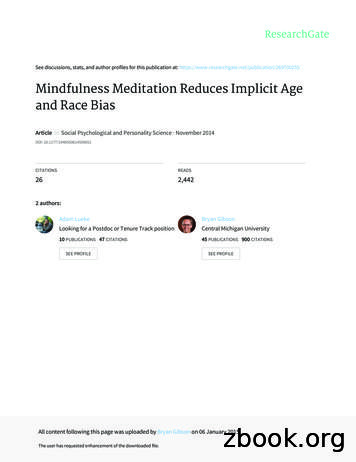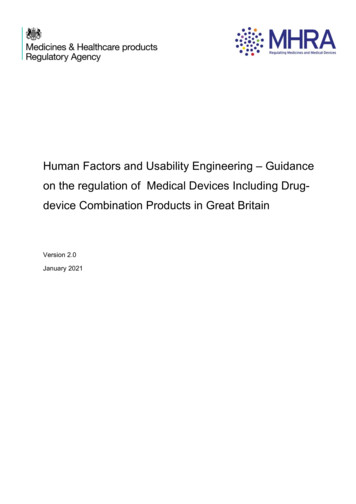Mindfulness And Resilience - ASPCP
Mindfulness and ResilienceHelen CotterwwHelen Cotter
What is mindfulness?“Mindfulness means paying attention in a particular way: on purpose, in the presentmoment, and non-judgementally.” Jon Kabat-Zinn“Awareness of present experience with acceptance.” Ron Siegal“Mindfulness is simply being aware of what is happening right now without wishing itwere different; enjoying the pleasant without holding on when it changes (which itwill); being with the unpleasant without fearing it will always be this way (which itwon’t).” James Baraz
Why practice mindfulness?Research shows that a regular mindfulness practice can:- reduce stress, anxiety and depression- improve memory and sleep- increase mental and physical stamina- increase capacity to cope with chronic pain- increase resilience
Research PublicationsSource: American Mindfulness Research Association (AMRA)
The practice of mindfulnessFormal practice- sitting meditation- walking meditation- body scanInformal practice- awareness of present moment experience during daily activities
Mindfulness is not- positive thinking- just a relaxation technique- trying to empty your mind- going into a trance or ‘zoning out’- a quick fix
Breath awareness practice
Establishing a practice“Mindfulness isn't difficult, we just need to remember to do it.” Sharon SalzburgFormal practiceChoose a regular time and place to meditateLet others know you don’t want to be disturbedTurn off your phone!Meditate with othersAttend a class or a courseInformal practiceChoose a daily activity to practise mindfully e.g. drinking a cup of tea, washing up, brushing your teeth, havinga shower, eating lunch, going for a walk.Identify ‘mindfulness bells’ or reminders to practice in your day e.g. phone ringing or buzzer call, sitting downat your desk, walking through the doorway of a patient’s room, red traffic lights on the drive to and from work.
Can you just be here now?
The Tricky Brain by Dr James KirbyCompassionate Mind Foundation
Emotional Regulation Systems by Professor Paul GilbertCompassionate Mind Foundation
“It is remarkable how liberating it feels to be able to see that your thoughtsare just thoughts and that they are not 'you' or 'reality.' For instance, if youhave the thought that you have to get a certain number of things donetoday and you don't recognize it as a thought but act as if it's the 'the truth,'then you have created a reality in that moment in which you really believethat those things must all be done today.” Jon Kabat-Zinn
In effect, the brain is like Velcro for negativeexperiences, but Teflon for positive ones. Thatshades “implicit memory” – your underlyingexpectations, beliefs, action strategies, andmood – in an increasingly negative direction.Rick Hanson - Hardwiring Happiness
“Neurons that fire together wire together. Mental statesbecome neural traits. Day after day, your mind isbuilding your brain. This is what scientists callexperience-dependent neuroplasticity.”“By taking just a few extra seconds to stay with apositive experience—even the comfort in a singlebreath—you’ll help turn a passing mental state intolasting neural structure.”Rick Hanson - Hardwiring Happiness
Taking in the goodA practice by Rick Hanson Look for positive facts, and let them become positiveexperiences Savour the positive experience- sustain it for 10-20 seconds- feel it in your body and emotions- intensify it Sense and intend that the positive experience is soakinginto your brain and body registering deeply inemotional memory
“Taking in the good is not about putting a happy shiny face oneverything, nor is it about turning away from the hard thingsin life. It's about nourishing well-being, contentment, andpeace inside that are refuges you can always come from andreturn to.”Rick Hanson - Buddha’s Brain
Resources for Mindfulness and ResilienceBooksMindfulness: A Practical Guide to Finding Peace in a Frantic World by Mark Williams and Danny PenmanMindfulness for Health: A Practical Guide to Relieving Pain, Reducing Stress and Restoring Well-Being by VidyamalaBurch and Danny PenmanThe Mindful Way Through Depression by Mark Williams, John Teasdale, Zindel Segal and Jon Kabat-ZinnThe Mindful Way Through Anxiety by Susan M. Orsilly and Lizabeth RoemerMindful Eating by Jan Chozen BaysThe Sleep Book by Guy MeadowsHardwiring Happiness by Rick HansonResilient by Rick HansonMindful Compassion by Paul Gilbert and ChodenAppsHeadspace (for daily led meditations)Gratitude
Questions and enquiries welcomewww.helencotter.comemail: hello@helencotter.comtelephone: 07815 697911
Identify ‘mindfulness bells’ or reminders to practice in your day e.g. phone ringing or buzzer call, sitting down at your desk, walking through the doorway of a patient’s room, red traffic lights on the drive to and from work. “Mindfulness isn't difficult, we just need to remember to do it.” Sharon Salzburg
Mindfulness Based Stress Reduction Mindfulness is a popular subject in the press as a way to improve wellbeing, and the NHS has adopted mindfulness approaches in clinical care and in the workplace. This course is intended to help you understand what Mindfulness is, but much more importantly to experience Mindfulness.
How Mindfulness Helps to Manage Anxiety . Mindfulness practice provides us with the tools required to observe the true nature of our present moment reality, helping us to gain clarity that puts anxiety in a new light. Embracing mindfulness promotes healthy management of anxiety in the following ways. Mindfulness reconnects us to the present moment.
We focused on the impact of mindfulness on implicit age and racial bias as measured by implicit asso-ciation tests (IATs). Participants listened to either a mindfulness or a control audio and then completed the race and age IATs. Mindfulness meditation caused an increase in state mindfulness and a
Learning about mindfulness -Module 1 Core concepts of Mindfulness Meditation Mindfulness is the awareness that arises through paying attention, on purpose, in the present moment, non-judgementally (Jon Kabat-Zinn) Maintaining a moment-by-moment awareness of our thoughts, feelings, bodily sensations, and surrounding environment
University Counseling Center. WHAT IS MINDFULNESS? What is Mindfulness? Mindfulness Training at Beginning Mindfulness Resources Related Links John Lennon captured the essence of non-mindful livin
Mindfulness in Schools and Colleges Mindfulness is becoming increasingly a usual part of the school day; helping children, young people, and teachers to develop mental resilience and the ability to manage their stress levels. Drawing on research of schools’ and college’s experiences with mindfulness, here are some of the benefits:
FRM:SG2.SP2 Establish Resilience Budgets FRM:SG2.SP3 Resolve Funding Gaps FRM:SG3 Fund Resilience Activities FRM:SG3.SP1 Fund Resilience Activities FRM:SG4 Account for Resilience Activities ; FRM:SG4.SP1 Track and Document Costs FRM:SG4.SP2 Perform Cost and Performance Analysis FRM:SG5 Optimize Resilience Expenditures and Investments
Human Factors and Usability Engineering – Guidance on the regulation of Medical Devices Including Drug-device Combination Products in Great Britain Version 2.0 January 2021 . Human Factors and Usability Engineering – Guidance for Medical Devices Including Drug-device Combination Products MHRA September 2017 v1.0 Page 2 of 35 Contents 1 Introduction and context . 4 2 The regulatory .























